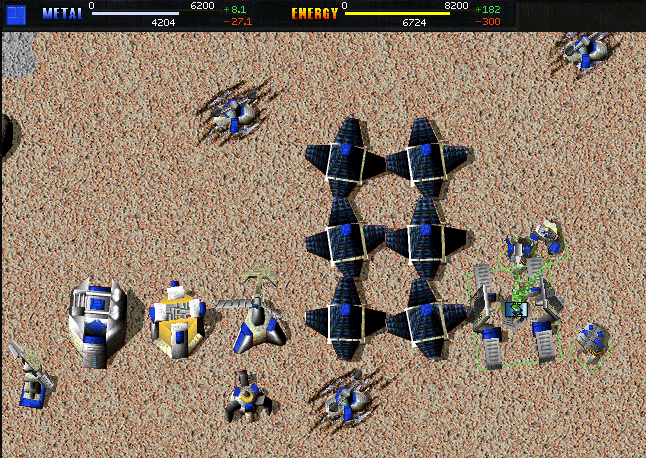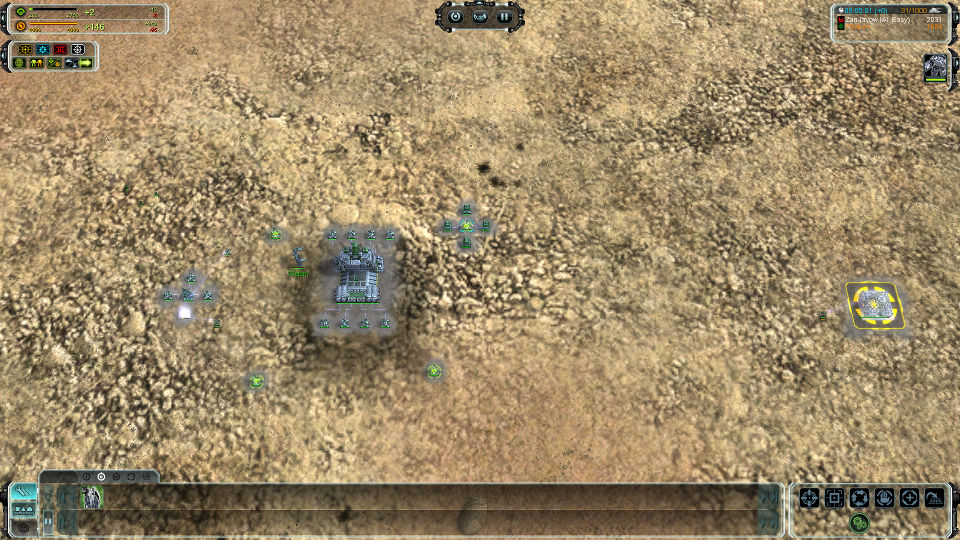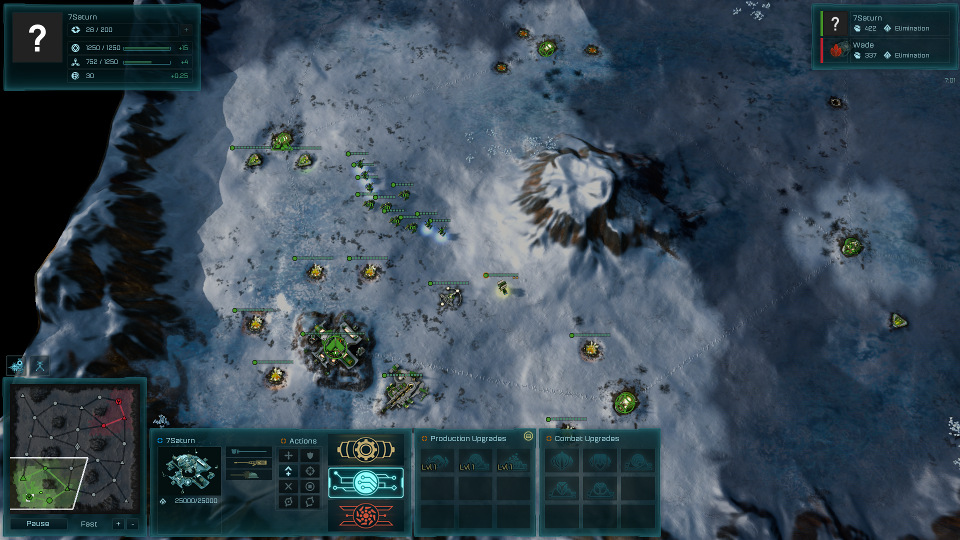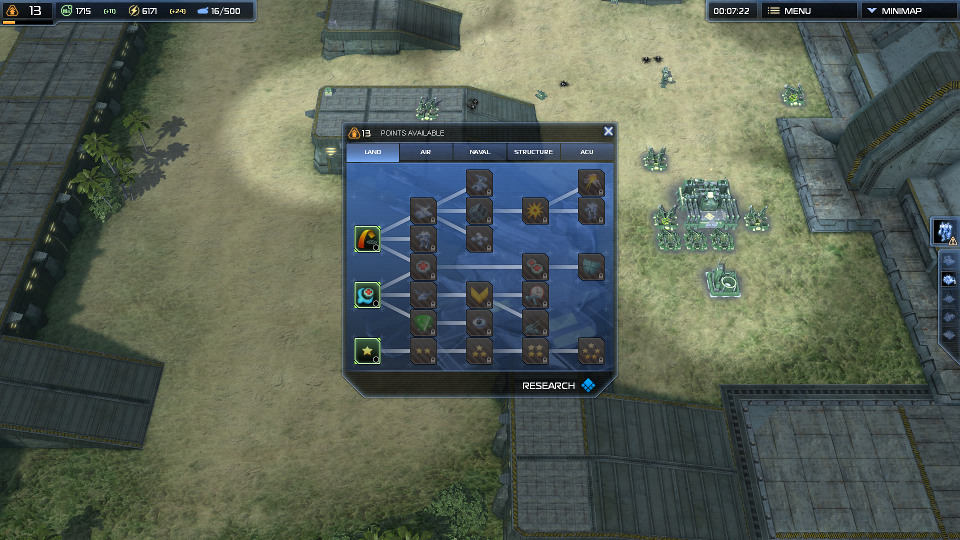Table of Contents
Total Annihilation Mechanics
Origin
Total Annihilation (short: TA) is a game that follows slightly modified resource mechanics. Unlike games such as Starcraft or Star Trek: Armada where you first collect resources and then spend them in one go on a unit or building (so it's more about owning resources), in Total Annihilation and derivative games the rate of resource collection and their expenditure is directly mechanic-determining. Also are resource spots (metal/mass/geothermic/radioactives) usually giving infinite resources at some sort of maximum rate, meaning, the resources are available during the entire game, much in contrast to games such as the ones already mentioned, where resource spots will run out of resources after a while. This makes holding such positions a lot more relevant.
Principle Economy Mechanics
Metal for building, energy for almost everything
Usually it is a combination of energy and metal or mass that determines the production possibilities. While metal/mass is needed to produce units or ammunition (e.g. a nuclear missile) energy is also used for other things, e.g. running a radar, using cloaking devices or maintaining shields. Very often also the extraction of metal requires energy. From this mechanic's point of view, energy is actually the more important resource than metal. Because without metal you can't produce anything/less, but you can still use shields or radar installations, while without energy you can't do either. Metal, on the other hand, determines in the end which production speeds are possible, even with an oversupply of energy.
Income rate vs. construction circumstances
Less relevant for the game is the current amount of energy or metal in the players possession. Rather, the rate of procurement determines the effectivity of the economy, in conjunction with the current resource storage capacity. (In most other strategy game mechanics this is in principle the same, but the construction is more oriented towards resource costs in fixed packages. The rate only determines how fast these are refilled and usually you can stack up resources infinitely, so you cannot waste resources by not using them.) For this reason also there is usually some sort of fixed minimum income, e. g. in TA the Commander gives a small amount of energy and metal income, while in Ashes of the Singularity: Escalation, the Nexus gives a basic rate of metal income. With out this, a player without a resource spot would be finished finally, while with that basic income rate you can always start over from scratch, trying to claim resource spots.
This is further complicated by two other factors that (can) determine production rates. On the one hand, the so-called build power, i. e. the speed at which a certain construction unit or building can produce, determines how quickly a building or unit can be completed. On the other hand, the construction time for a building or unit is not simply determined by the amount of energy and metal required, but also by a kind of complexity factor of the unit to be build, which can result in different construction times for different units even when they require the same amount of resources and the same construction unit is used. You can think of it as the build power increasing the build speed and the complexity as slowing it down.
Speed by numbers
Usually, production can be accelerated by involving other units in the building process, e. g. having several construction units construct a building. Depending on the variation, there are even buildings that do nothing but speed up processes (e. g. building, repairing and dismantling). But this is exactly where the basis of the rate-dependent economy becomes apparent: no matter how many units you bring in, on the long run you can never build faster than your current income allows. You may use up stored resources very fast, but once your storage runs empty, you fully depend on the rate of income. In most cases, the entire available resource rate is then distributed among the various construction orders within the game mechanics, proportionally according to build power and complexity. This means that if you want to speed up a certain construction process, but still want to use your economy to full capacity, you use as many construction units as possible on that order, but keep the other processes running. As a result, however, the other construction orders are slowed down.
Storage buildings
Load peaks can usually be buffered by means of storage buildings in which energy or metal can be stored. In this way, it is possible to achieve a much higher construction speed than the mere income would allow. However, on the long run, a high production rate can only be maintained through a more powerful income base. There are usually different buildings that supply metal or energy (or both). Often the units and buildings already constructed have low storage capacities as well.
Metal sources
Metal/mass is usually (also) provided at special locations on the card, possibly with different extraction rates at different locations (extractor). This gives you a certain location dependency, which can mean strategic weaknesses. In return, however, extractors involve relatively low energy costs. The extraction building used can also result in different extraction rates (but usually also different energy costs).
Power plants
Energy, on the other hand, can (mostly) either be collected relatively cheaply at special locations (e. g. geothermal power plants), or a little more expensively (especially in terms of space requirements and building costs), regardless of position. There are also different sources that may introduce a tactical aspect through volatility vs. steadiness (e. g. wind energy, which simply delivers nothing when there is no wind, but more when there is strong wind than a solar plant vs. fusion reactor or solar plant, which always deliver a fixed rate).
Converter
Both resources are often linked with conversion buildings, usually energy to metal/mass (converter, metal maker). These buildings in particular allow the player to become mostly independent from map features, because you just have to build enough position-independent energy sources and corresponding converters. It is this aspect that makes more compact energy sources and converters worthwhile, as they offer the opponent fewer attack points than, for example, metal mining sites distributed on the map or large wind turbine farms. These advantages are often at the expense of the fact that buildings that are destroyed cause (sometimes considerable) damage to buildings and units in the surrounding area and, above all, are significantly more expensive to purchase or maintain. The energy costs for the maintenance of metal extractors are usually low or zero, while a converter is relatively expensive.
Bonuses through adjacent buildings
Bonuses such as reduced energy consumption of a building with directly adjacent energy sources or increased yield of a metal extractor with directly adjacent metal storage facilities may add an additional level of complexity. However, it is often the case that (thanks to a limit of unit numbers) it makes sense in both the medium and long term to use less of these bonuses and instead simply to use the most space-efficient energy or metal sources.
Unlimited resources
There is at least one game (Supreme Commander - Forged Alliance) which, as a kind of super-weapon, provides a resource source that has no rate limit, i.e. ultimately infinite income. Whoever owns this building has de facto only the number and type of construction buildings and units as a limiting factor for the economy. Accordingly, this building is intended for the very late game and already requires considerable economic power for procurement.
Illustration
Here are some examples from games using the economy from Total Annihilation. The following screen shot was taken from TA itself:

Some of the basic buildings from Total Annihilation (from left to right):
- Radar installation, requiring energy to be active,
- metal storage, increasing the limit of metal storage,
- energy storage, increasing the limit of energy storage,
- wind generator (top), providing energy, rate can change at any given time,
- metal generator (bottom), using up energy and in turn generating metal income,
- six solar panels providing a fixed income of energy,
- three metal extractors, providing metal at a rate defined by the actual metal source spot,
- one factory using up energy and metal during production, two construction k-bots supporting the build process (speeding it up but also increasing the drain on the economy) and
- the commander, also supporting the build process.
On top you find the resource bars, on the left showing a metal capacity of 6200, an actual amount of 4204 in possession and a rate of 8.1 income and a drain of 27.1. On the right the same information for the energy are presented, 8200 as the current storage capacity, 6724 energy in possession, a drain of 300 and an income of 182. This situation would not be sustainable for long. Once the metal storage runs empty, the production rate will drop to approximately 30% (metal limit), while the energy drain at this time will also drop to that value, leaving it at an absolute number of approximately 90, which can be sustained well, as the energy drain is well within the income rate.
However, the metal will run out in about 221 seconds while the energy will run out earlier, after 56 seconds. So the limiting factor will be the energy for a while, when the metal is still being drained, until it reaches 0 metal stored. This will go on for approximately another 190 s, while the rest of the remaining metal stored will be drained, the energy income will not be sufficient to provide for production on this rate and sustaining the radar facility and the metal converter. Energy will drop to zero, being overloaded by almost a factor of 1.7, also slowing down production by this factor.
This is a situation to be avoided, but can be found in all energy/metal centered variations of this economy mechanics. Once the metal runs out, the situation will be well in hand. (Metal drain is limited by income to 8.1, which is 30% of required, limiting the energy drain by the production to the same level, leaving it well below an energy drain of 181.) But for that period of time, while the metal is being drained and the energy is not sufficient, the player may be vulnerable. This kind of deliberations are important, as they do not just have an economical impact, but also militarily. Imagine shields or radar being turned off due to a lack of energy while an attack of an opponent is currently ongoing or on the way. This might very well cost the player a battle if not the entire match. One easy solution here would be to stop supporting the production by the commander and maybe one of both of the constructors. In turn it would be advisable to increase energy income by adding more solar panels or wind generators.
Note, that the actual position of a metal extractor on its metal spot can influence the amount of metal actually gained. It is even possible to place an extractor anywhere on the map. If a metal extractor is too far way from a metal spot, it will not gather any resources. In contrast, the position of any energy generator of metal converter has no influence on its yield.

This pictures was taken from Supreme Commander - Forged Alliance. It shows the following things:
- A metal income of 10, drain of 8 while 280 of 2760 units in storage are present.
- The energy income is 240 with a drain of 95. The residual amount of energy is 100% of the 4000 maximum units.
- There are four metal extractors, one of them begin boosted by another four metal storage units, increasing its income from 2 to 3 due to adjacency bonus.
- There are eleven small energy generators, eight of them directly adjacent to the factory, which reduces its energy drain due to another bonus.
- The same bonus will be granted to the radar facility on the left, where the fourth energy generator is almost finished.
- On the right hand side an additional power plant is being build, placed on a geothermal spot. This setting is already very promising, as there is enough energy available, stored and income as well and even the metal is increasing.
A specialty of Supreme Commander are bonuses. They can be very important. E. g., the tech three metal extractor can either gather 18 metal per second when placed alone or 27, when enhanced by foure adjacent metal storage facilities. Same goes for the energy. Either draining units may require less energy when placed directly next to a power plant or storage facility, or the output of a generator can be boosted.
While normal energy generators can be placed rather freely (only depending on the shape of the ground and the size of the generator), metal extractors require to be placed on certain spots, as well as the geothermal power plants, which require a corresponding spot. Other than in TA, you are not able to place it anywhere else. Same goes for geothermal power plants. In turn, the energy gain of the spot-dependent resource sources is rather high (in comparison of the building cost) resp. the drain of energy for the metal extractor is very low. This is also an important concept of the TA mechanics, resource spots being of tactical importance, but not being unavoidable, as there are energy generators and metal converters, leaving the resource gathering not being tied to such spots for the entirety of a match. In the beginning they are almost unavoidable while in the late-game a player might forgo them altogether, making the player independent of the energy and metal spots.
The resource spot concept of Ashes of the Singularity: Escalation differs by some degree:

In this screenshot you can see two spots of Metal (circular spots, left lower corner, right lower corner, upper middle) and a Radioactives spot (triangle sport, upper left corner). All metal and radioactives spots are accompanied by energy spots, which have to be captured first. In contrast to TA or Supreme Commander, where you have to build an extractor on these spots, in Ashes it is already sufficient to capture such a spot to gain access to a portion of the resource income. However, the income is increased by a factor of four to eight when building extractors on the adjacent extractor spots. Ihe income is increased even more by so-called Amplifiers, placed on to of the energy spot, and this is not even the end of it as you can increase the income of such a region by deploying Refineries in the vicinity of an energy spot or send Harvesters to them.
While there are nominally three types of spots involved, the metal spot, the radioactives spot and the energy spot, the latter does not actually add to the economy as a resource (like the energy resource from TA), as it is only a strategic aspect of the game, not a resource by itself. You only require it for capturing and enhancing the actual resource sports, metal and radioactives and in addition, to ensure resource transfer to the Nexus of the player.
Other than with TA or Supreme Commander, the Energy spot adds to the complexity of the economy in the fashion as any resource region must have a direct connection via other resource regions to the players Nexus. Once a region is isolated from the Nexus, it does not add to the resource income of the player, even though he technically still controls this position.
In Balanced Annihilation the concept of metal spots is altered slightly:

This is a so-called metal map, showing the yield of the map with regards to metal. The more intense the green color is, the more metal the position gives. So there are not actually metal spots but sections of the map may yield metal or not. Usually these are again spots, so small areas where you can place the extractor and expect metal income. The shown FroobMetal_v3 is an extreme example, as the entire map can give metal, especially the corners, the center of the map and the direct connections of corners and center. The more elevated positions between the corners around the center are still giving metal but not to such an extreme extend. These so-called metal-maps accelerate the game considerably, as the only limit for unit and production expansion is energy, which can be placed anywhere. So in principle a player can avoid leaving his part of the map entirely and go straight for fast production, changing the game experience a lot.
Battle Concept
One important aspect behind the above mentioned economy mechanics is the emphasis on large scale battles. The creator of Total Annihilation, Chris Taylor, was unsatisfied with the usual strategy game mechanics and scale. His argument was that most so-called strategy games were actually tactical games, as real strategy, including bigger thought campaigns against the opponent, usually is not an issue.
Therefore many of his games actually make it feasible and meaningful, to think about unit production on a larger scale. That includes the mere ability of the game engines to support bigger numbers of units without breaking down by the sheer systems load and subsequent features to make deployment of large squads and their formations doable. That includes features like automatic air transport of ground units (ferry) via corresponding drop ships as well as infinite production loops and sequences along with combinations of the mechanics. So in practice you could run a factory with infinite production loop, point its rally point to the pick-up point of your drop ships and therefore automate the deployment of units to a distant point on the map. Another variation of this is the production/requisition of certain units, which can be placed anywhere on the map, while units produced by the corresponding factories are automatically tied to the requiring units' group and will try and get to them on their own.

A unit formation consisting of more than 450 units from one single player (and the unit supply limit is not even hit) is no problem in Supreme Commander - Forged Alliance. The infinite build loop reduces the management effort to almost nothing. The only thing the player has to keep track of is the economy supporting a fast build regarding resource income and also build power. Considering, that there are up to 8 players on a regular map (up to 16 when using the FAF mod), one can easily see, that this can lead to enormous battles.
Also units and weapons intended for large maps are very common, such as the “Big Bertha” attack cannon/artillery or strategic missiles (nukes). But also on a smaller scale the game mechanics are meant for a divers strategy, like different tech levels of units, ranging from simple reconnaissance units, medium tanks, heavy bombers to mobile artillery, shield batteries and jamming units. Also kind of a signature of this sort of game is the availability of rather big units, also called “experimental” units, which usually pack quite a punch and have a high amount of hitpoints. A lighter version of this concept are the so-called dreadnoughts and juggernauts of Ashes of the Singularity, which are kind of inherited from the Fat Boy unit from Supreme Commander, very strong units, that can call for the production of supporting units. Along with long range artillery and other “big” gun type units these are often referred to as game-enders, as very often successfully deploying them means the end of the match for the opponent.
So the general concept of TA and derived games could be described as “think big”. This also goes in terms of map sizes and match durations. While an average Starcraft 2 match rarely goes on for more than an hour, this is actually rather common for TA derived games. And for example SC2 maps can be scrolled end-to-end in a rather short time or with only few seconds scrolling time, while TA like maps usually are vast enough to make this not reasonable. Therefore also the concept of map presentation is often altered. While many other games have a mini map, showing the entire map, but still only operate properly via the main (more detailed) map, TA like games utilize the mouse scrolling wheel in order to simply change the zoom value of one map alone. So the current representation of the map is determined by the set zoom factor and the placement of the center of the screen on the map. That allows to simply zoom out and zoom in on another position of the map very fast, while at no point changing the unit selection or dispatching mechanics, as you simply work on a map with another current scale. This does not necessarily leave the mini map out altogether, but the emphasis on it is not as intense as it is in other games.
Research and Upgrades
Some variations, such as Supreme Commander 2 or Ashes of the Singularity: Escalation do feature a research and upgrade system, which is not so much based on a research tree alone but on gathering some sort of research resource, that is accumulating over time, usually by some sort of building providing it. In turn you need this resource to actually be able to research and enhance things. But those researched items/enhancements are available immediately after issuing their research, in contrast to other games, where you get the results after some time after issuing them. In case of Ashes of the Singularity, the gathered so-called Quanta can also be used for casting certain units or effects, such as instantly deploying a defense turret or speeding up the production of a factory.
Illustration Supreme Commander 2
Supreme Commander 2 actually reduced the research strictly to spending the research points on advancements for all kinds of units, the Commander and also the economy buildings such es extractors, factories and the research station itself.

Here you can see:
- one factory (big building),
- three energy generators,
- five mass extractors and
- one research station (smaller building on the bottom).
On the upper left corner you can see the amount of research points already gathered. The research tree includes not only upgrades to available units but also unlocks new unit types. So the research has a heavy influence on the available structures, units and functions of units and buildings. E. g. shields of any kind are not available without research.
Illustration Ashes of the Singularity
The game Ashes of the Singularity: Escalation features the research mechanics in form of globally enabled upgrades and on top, adding a casting mechanics as well, ranging from simple reconnaissance casts over economy boosts to even military unit addition.

Right in the middle you can find the Quantum Relay (of the Post Human Coalition faction). It gathers 0.25 Quanta per second. The metal and radioactives storage capacities were already enhanced (level 1), as well as the logistics value. Here the storage is not determined by actual storage buildings, as it would be the case for TA or Supreme Commander, but simply by the currently reached level of enhancement by Quanta. Quanta can also be used to cast for example a production speed boost on a factory or increase the logistics value (supply limit). Also weapons strength, radar range and the building hitpoints can be increased with Quanta. It adds to the complexity of the game and can be considered a third resource, similar to the energy of Starcraft Broodwar.